Junkers JU 390
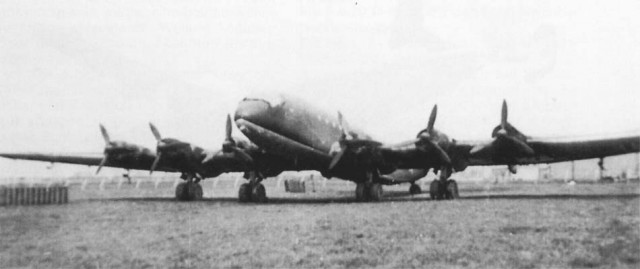
The Junker JU 390 was designed by the Nazi’s in 1942-43, it was intended to be used as a heavy transport, maritime patrol aircraft, and long-range bomber, a long-range derivative of the Ju 290. It was one of the aircraft designs submitted for the abortive Amerika Bomber project.
The plane was just over 112 feet long and had a wingspan of 165 feet and had a range of around 6000 miles.
Antonov AN-225
 Antonov An-225 with Buran atop at the Paris Air Show, image courtesy of Wikipedia
Antonov An-225 with Buran atop at the Paris Air Show, image courtesy of WikipediaThe Antonov An-225, initially developed for the task of transporting the Buran spaceplane, was an enlargement of the successful Antonov An-124. The first and only An-225 was completed in 1988. After successfully fulfilling its Soviet military missions, it was mothballed for eight years. It was then refurbished and re-introduced, and is in commercial operation with Antonov Airlines carrying oversized payloads.
The enormous plane is 275 feet long and has a wingspan of 290 feet!
Messerschmitt ME 323
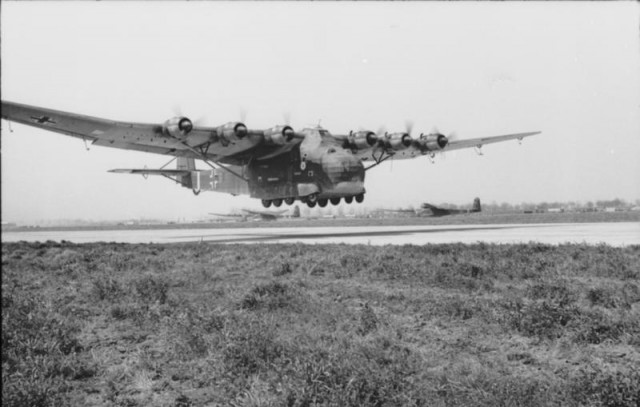 The ME 323 Giant, Image courtesy of the Bundesarchiv
The ME 323 Giant, Image courtesy of the BundesarchivThe Messerschmitt Me 323 was a German military transport aircraft of World War II. It was a powered variant of the Me 321 military glider and was the largest land-based transport aircraft of the war. A total of 213 are recorded as having been made.
The Me 323 was the result of a 1940 German requirement for a large assault glider in preparation for the projected invasion of Great Britain. After that operation was scrapped the need remained for a heavy transport that could deliver vehicles and supplies. The ME 321, the glider version, was produced first and in 1941 the decision was taken to produce a motorized variant, to be designated Me 323.
The maximum payload was around 12 tonnes, but it was a very slow aircraft having a top speed of only 177 MPH. It was just over 92 feet long and had a wingspan of over 181 feet, none of the ME-323s have survived the war.
Blohm & Voss BV 238
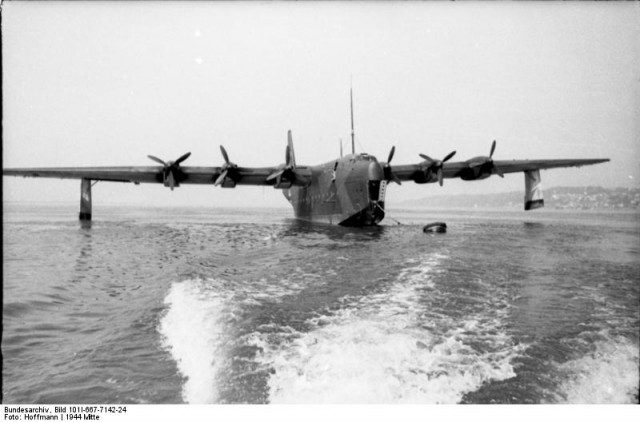 The prototype BV 238 V1 in June 1944, image courtesy of the Bundesarchiv
The prototype BV 238 V1 in June 1944, image courtesy of the BundesarchivThe sole completed BV 238 was strafed and sunk while docked on Schaalsee, the RAF discovered it in late april 1945. The Allies were reportedly concerned that Adolf Hitler could use it to escape to South America, and so an attack followed shortly afterwards. The aircraft was attacked by Hawker Typhoons, or Hawker Tempests. Their strafing set the engines alight, and the aircraft burnt and sank with only part of a wing remaining above the surface. Production of two other prototypes was begun but neither was finished.
Martin JRM Mars
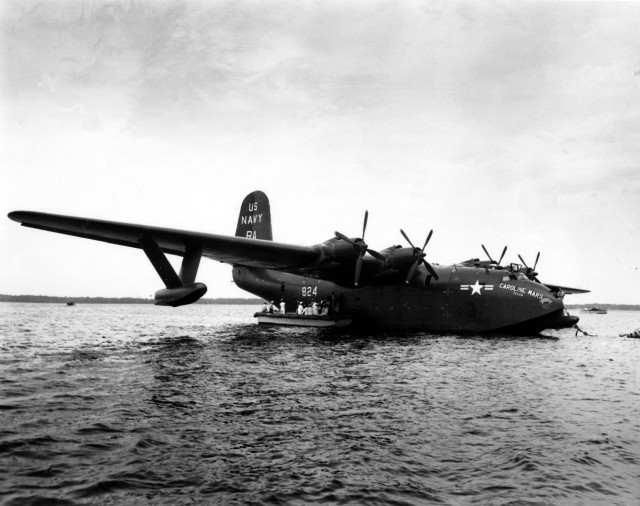 JRM-2 Caroline Mars in the St. Johns River at Jacksonville, Florida in 1949
JRM-2 Caroline Mars in the St. Johns River at Jacksonville, Florida in 1949The Martin JRM Mars is a large, four-engined cargo transport seaplane originally designed and built in limited numbers for the U.S. Navy during World War II. It was the largest Allied flying boat to enter production, although only seven were built. The United States Navy contracted the development of the XPB2M-1 Mars in 1938 as a long range ocean patrol flying boat, which later entered production as the JRM Mars long range transport.
Convair B-36 “Peacemaker”
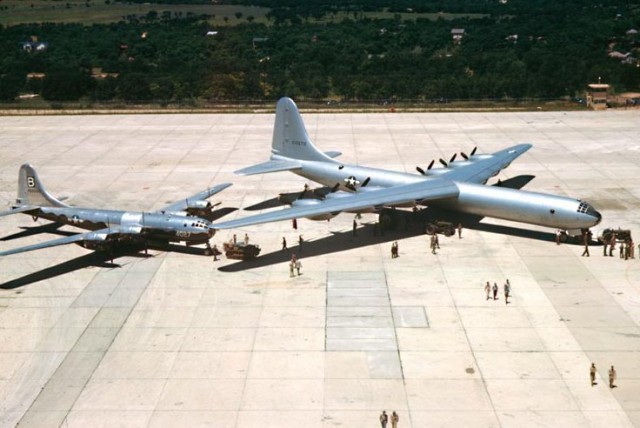 The huge new XB-36 prototype alongside the Boeing B-29 Superfortress.
The huge new XB-36 prototype alongside the Boeing B-29 Superfortress. The Convair B-36 “Peacemaker” was a strategic bomber and operated solely by the United States Air Force from 1949 to 1959. The aircraft was unveiled on 20 August 1945, and flew for the first time on 8 August 1946. The B-36 was the largest mass-produced piston engine aircraft ever made. It had the longest wingspan of any combat aircraft ever built at 230 ft. The B-36 was the first bomber capable of delivering any of the nuclear weapons in the U.S. arsenal from inside its four bomb bays without aircraft modifications.
With a range of 10,000 mi and a maximum payload of 72,000 lb, the B-36 was the world’s first manned bomber with an unrefueled intercontinental range.
Convair XC-99
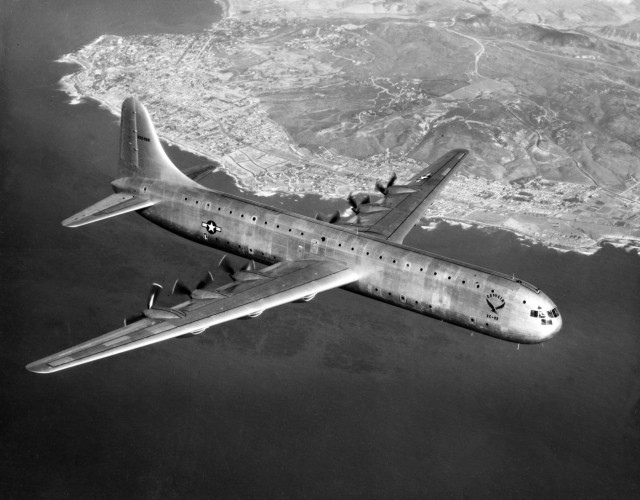 The single U.S. Air Force Convair XC-99 in flight
The single U.S. Air Force Convair XC-99 in flightThe Convair XC-99 is a prototype heavy cargo aircraft. It was the largest piston-engined land-based transport aircraft ever built, and was developed from the Convair B-36 bomber, sharing the wings and some other structures with it. The first flight was on 24 November 1947 in San Diego, California, and after testing it was delivered to the Air Force on 26 May 1949. The Convair Model 37 was a planned civil passenger variant based on the XC-99 but was not built.
In July 1950, the XC-99 flew its first cargo mission, “Operation Elephant.” but after a few missions the US Air Force determined that it had no need for such a large, long-range transport at that time, and no more were ordered. The sole XC-99 served until 1957, including much use during the Korean War, its last flight was on 19 March 1957, landing at Kelly Air Force Base, where it would remain for the next 47 years.
It is currently disassembled and in storage in Arizona with no plans to restore it in the foreseeable future. When still assembled it had a length of 182 feet and a wingspan of 230 feet.
Boeing B-52
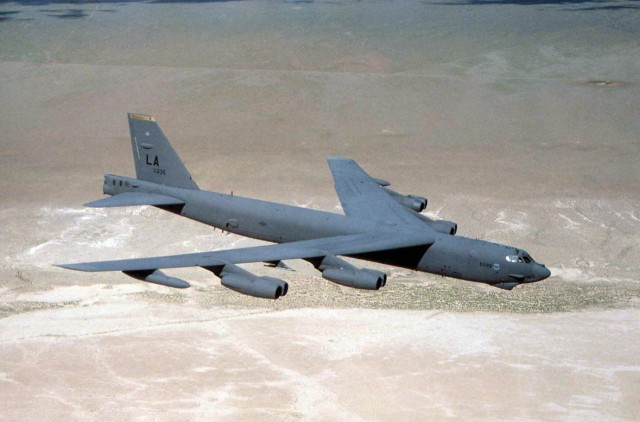
Beginning with the successful contract bid in June 1946, the B-52 design evolved from a straight wing aircraft powered by six turboprop engines to the final prototype YB-52 with eight turbojet engines and swept wings. The B-52 took its maiden flight in April 1952. Built to carry nuclear weapons for Cold War-era deterrence missions, the B-52 Stratofortress replaced the Convair B-36. A veteran of several wars, the B-52 has dropped only conventional munitions in combat.
The B-52 has been in active service with the USAF since 1955. As of 2012, 85 were in active service with nine in reserve. The B-52 completed fifty years of continuous service with its original operator in 2005; after being upgraded between 2013 and 2015, it is expected to serve into the 2040s.
It has a length of 159 feet and a wingspan of 185 feet.
Hughes H-4 Hercules
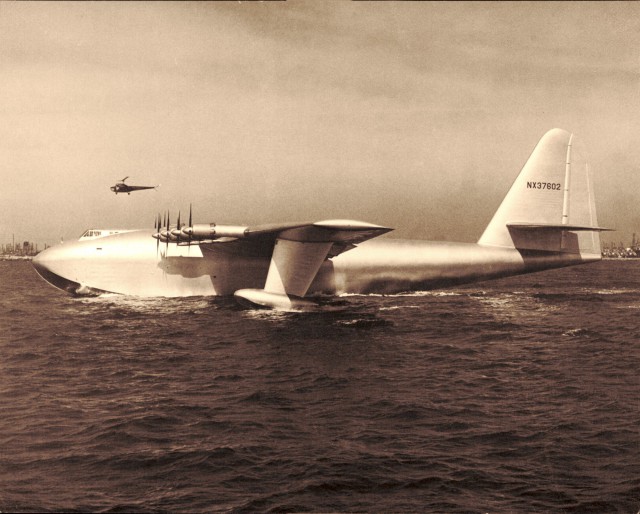
The Hughes H-4 Hercules is a prototype heavy strategic airlift military transport aircraft. Intended as a transatlantic flight transport for use during World War II, it was not completed in time to be used in the war. The aircraft made only one brief flight on November 2, 1947, and the project never advanced beyond the single example produced.
Built from wood because of wartime restrictions on the use of aluminium and concerns about weight, it was nicknamed by critics the “Spruce Goose”, although it was made almost entirely of birch. The Hercules is the largest flying boat ever built and has the largest wingspan of any aircraft in history.
It is on display, and remains in good condition at the Evergreen Aviation & Space Museum in McMinnville, Oregon, United States.
The length of the Hercules is 218 feet and an incredible wingspan of 320 feet
Lockheed C-5 Galaxy
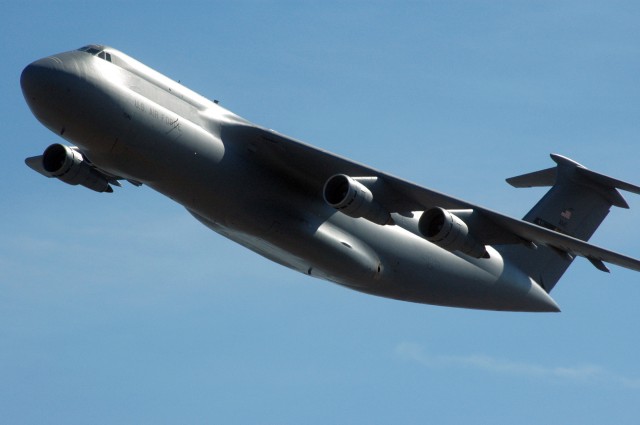 C-5 Galaxy just after takeoff.
C-5 Galaxy just after takeoff.The Lockheed C-5 Galaxy provides the United States Air Force with a heavy intercontinental-range strategic airlift capability, one that can carry massive loads.
The C-5 Galaxy has been operated by USAF since 1969. In that time, it has been used to support US military operations in all major conflicts including Vietnam, Iraq, Yugoslavia and Afghanistan; as well as in support of allies, such as Israel during the Yom Kippur War and operations in the Gulf War. The C-5 has also been used to distribute humanitarian aid and disaster relief, and supported the US Space Shuttle program run by NASA.
The airplane is 247 feet long and has a wingspan of just over 229 feet, it can carry a staggering 211 tons of cargo.

Δεν υπάρχουν σχόλια:
Δημοσίευση σχολίου